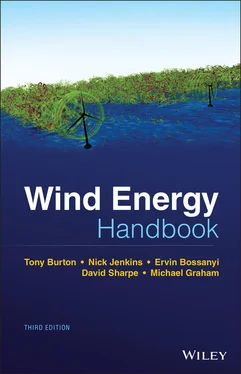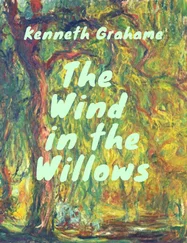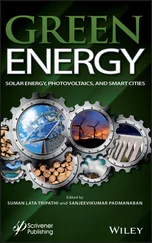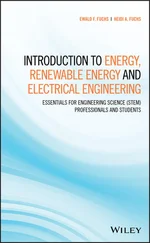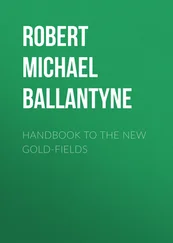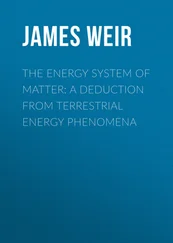17 Glauert, H. (1935a). Airplane propellers. In: Aerodynamic Theory, vol. 4, Division L (ed. W.F. Durand), 169–360. Berlin: Julius Springer.
18 Glauert, H. (1935b). Windmills and fans. In: Aerodynamic Theory, vol. 4, Division L (ed. W.F. Durand), 169–360. Berlin: Julius Springer.
19 Goldstein, S. (1929). On the vortex theory of screw propeller. Proc. R. Soc. Lond. 123: 440.
20 Himmelskamp, H. (1945). Profile investigations on a rotating airscrew. Doctoral thesis, Gottingen.
21 Hoerner, S.F. (1965). Pressure drag on rotating bodies. In: Fluid‐Dynamic Drag, 3–13. Midland Park, NJ, USA: Hoerner.
22 Howe, M.S. (1991). Noise produced by a saw‐tooth trailing edge. J. Acoust. Soc. Am. 90: 482–487.
23 Jamieson, P. (2011). Innovation in Wind Turbine Design. UK: Wiley.
24 Jamieson, P. (2018). Innovation in Wind Turbine Design, 2e. UK: Wiley.
25 Johnson, S.J., van Dam, C.P., and Berg, D.E. (2008). Active load control techniques for wind turbines. Sandia Rept., SAND2008‐4809.
26 Joukowski, J.N. (1920). Windmills of the NEJ type. Transactions of the Central Institute for Aero‐ Hydrodynamics of Moscow: 405–430.
27 Katz, J. and Plotkin, A. (1991). Low Speed Aerodynamics: From Wing Theory to Panel Methods. New York, USA, McGraw‐Hill.
28 Lanchester, F.W. (1915). A contribution to the theory of propulsion and the screw propeller. Trans. Inst. Naval Architects 57: 98.
29 Lin, C.C. (1955). The Theory of Hydrodynamic Stability. UK: Cambridge University Press.
30 Lock, C.N.H. (1924). Experiments to verify the independence of the elements of an airscrew blade. ARCR R&M No. 953.
31 Lynch, C.E. and Smith, M. (2009). A computational study of the aerodynamics and aeroacoustics of a flat‐back airfoil using hybrid RANS‐LES. ResearchGate, https://www.researchgate.net/publication/253982002.
32 Madsen, H.A., Mikkelsen, R.F., Oye, S. et al. (2007). A detailed investigation of the blade element momentum (BEM) model based on analytical and numerical results and proposal for modifications of the BEM model. Jnl. Physics Conf. Series 75: 012016.
33 Madsen, H.A., Bak, C., Doessing, M. et al. (2010). Validation and modification of the blade element momentum theory based on comparisons with actuator disc simulations. Wind Energy 13: 373–389.
34 Mikkelsen R.F. (2003). Actuator disc methods applied to wind turbines. PhD thesis, Tech. University of Denmark, Lyngby.
35 Moriarty, P.J., Guidati, G., and Migliore, P. (2005). Prediction of turbulent inflow and trailing edge noise for wind turbines. AIAA paper 2005‐2881.
36 Peters, D.A. and Modarres, R. (2013, 2014). A compact closed‐form solution for the optimum, ideal wind turbine. Wind Energy 17 (4): 589–603. Published online in 2013, https://doi.org/doi.org/10.1002/we.1592.
37 Richards, E.J. and Meade, D.J. (1968). Noise and Acoustic Fatigue in Aeronautics. UK: Wiley.
38 Ronsten, G. (1991). Static pressure measurements in a rotating and a non‐rotating 2.35 m wind turbine blade. Comparison with 2D calculations. Proceedings of the EWEC '91 Conference, Amsterdam.
39 Sharpe, D.J. (2004). Aerodynamic momentum theory applied to an energy extracting actuator disc. Wind Energy 7: 177–188.
40 Shen, W.Z., Mikkelsen, R.F., and Soerensen, J.N. (2005). Tip‐loss corrections for wind turbine computations. Wind Energy 8: 457–475.
41 Snel, H., Houwink, R., Bousschers Piers, W.J., van Bussel, G.J.W. and Bruining, A. (1993). Sectional prediction of 3‐D effects for stalled flow on rotating blades and comparison with measurements. Proceedings of the EWEC '93 Conference, Lübeck‐Travemünde, Germany.
42 Soerensen, J.N. and Shen, W.Z. (2002). Numerical modelling of wind turbine wakes. J. Fluids Eng. 124: 393–399.
43 Soerensen, J.N. and van Kuik, G.A.M. (2011). General momentum theory for wind turbines at low tip speed ratios. Wind Energy 14: 821–839.
44 Soerensen, J.N., Shen, W.Z., and Munduate, X. (1998). Analysis of wake states by a full‐field actuator‐disc model. Wind Energy 88: 73–88.
45 Sørensen, N.N. (1995). General purpose flow solver applied to flow over hills. Risø‐R‐827(EN).
46 Tangler, J. L., and Somers, D. M. (1995). NREL airfoil families for HAWTs. AWEA '95, Washington, DC, USA.
47 Taylor, G.I. (1944). The air resistance of flat plates of very porous material. Aero. Res. Council (UK), Rept. & Memo. No. 2236.
48 Timmer, W.A. and van Rooij, R.P.J.O.M. (2003). Summary of the Delft University wind turbine dedicated airfoils. J. Solar Energy Eng. 125: 488–496.
49 Troldborg, N., Soerensen, J.N., and Mikkelsen, R.F. (2006). Actuator line computations of wakes of wind turbines in wind‐farms. IEA. Annual Rept. Annex XI Proc. Joint Action on Aerodynamics of Wind Turbines.
50 Wagner, S., Bareiss, R., and Guidati, G. (1996). Wind Turbine Noise. New York: Springer Verlag.
51 Wang, Q., Chen, J.T., Cheng, J.T. et al. (2015). Wind turbine airfoil design method with low noise and experimental analysis. J. Beijing Univ. Aero. Astro. 41: 23–28. Also as DTU‐Orbit: https://doi.org/10.13700/j.bh.1001-5965.2014.0072.
52 White, F.M. (1991). Viscous Fluid Flow. New York: McGraw‐Hill.
53 Wilson, R.E., Lissaman, P.B.S., and Walker S.N. (1974). Applied aerodynamics of wind power‐machines. Oregon State University, NTIS: PB‐238‐595.
54 Wimshurst, A. and Willden, R. (2018). Computational observations of the tip‐loss mechanisms experienced by horizontal axis rotors. Wind Energy 21: 792.
55 Wood, D.H. (1991). A three‐dimensional analysis of stall‐delay on a horizontal‐axis wind turbine. J. Wind Eng. Ind. Aerodyn. 37: 1–14.
56 Young, A.D. and Squire, H.B. (1938). The calculation of the profile drag of aerofoils. Aero. Res. Council (UK), Rept. & Memo. No. 1838.
57 Zhu, W.T., Heilskov, N., Shen, W.Z., and Soerensen, J.N. (2005). Modeling of aerodynamically generated noise from wind turbines. J. Solar Energy Eng. 127: 517–528.
58 Zhu, W.T., Shen, W.Z., and Soerensen, J.N. (2016). Low noise airfoil and wind turbine design. In: Wind Turbine Design, Control and Applications, Ch.3. (ed. A.G. Aissaoui), 55. Intech Open https://doi.org/10.5772/63335.
1 http://www.nrel.gov/wind
2 http://www.nrel.gov/wind/publications.html
3 https://wind.nrel.gov/airfoils/Shapes/S809_Shape.html.
4 http://www.windpower.org/en
5 http://www.lr.tudelft.nl/live/pagina.jsp?id=9e2f503f-3b65-44bc-aba4-a30033400ea7&lang=en
1 Anderson, J.D. (1991). Fundamentals of Aerodynamics, 2e. Singapore: McGraw‐Hill.
2 Ashill, P.R., Fulker, J.L., and Hackett, K.C. (2005). A review of recent developments in flow control. Aeronaut. J. 109: 205–232.
3 Barnard, R.H. and Philpott, D.R. (1989). Aircraft Flight: A Description of the Physical Principles of Aircraft Flight. Singapore: Longman.
4 Duncan, W.J., Thom, A.S., and Young, A.D. (1970). Mechanics of Fluids, 2e. London: Edward Arnold.
5 Eggleston, D.M. and Stoddard, F.S. (1987). Wind Turbine Engineering Design. New York: Van Nostrand Reinhold Co.
6 Fung, Y.C. (1969). An Introduction to the Theory of Aeroelasticity. New York: Dover.
7 Hansen, M.O.L. (2000). Aerodynamics of Wind Turbines. London: James & James.
8 Johnson, W. (1980). Helicopter Theory. New York: Dover.
9 Manwell, J.F., McGowan, J.G., and Rogers, A.L. (2002). Wind Energy Explained. Chichester: Wiley.
10 Prandtl, L. and Tietjens, O.G. (1957). Applied Hydro‐ and Aeromechanics. New York: Dover.
11 Stepniewski, W.Z. and Keys, C.N. (1984). Rotary‐Wing Aerodynamics. New York: Dover.
Appendix A3 Lift and drag of aerofoils
The lift and drag of a body immersed in an oncoming flow are defined as the components of force on the body in the directions normal and parallel, respectively, to the incident flow direction.
Читать дальше
